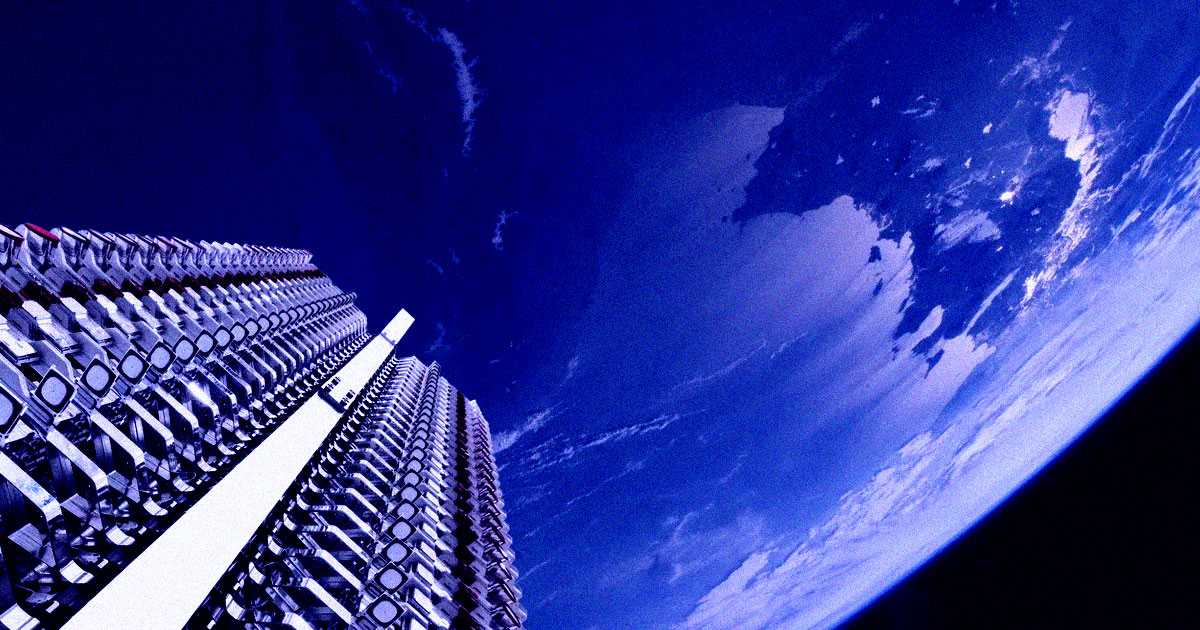Abstract from the paper in the article:
https://agupubs.onlinelibrary.wiley.com/doi/10.1029/2024GL109280
Large constellations of small satellites will significantly increase the number of objects orbiting the Earth. Satellites burn up at the end of service life during reentry, generating aluminum oxides as the main byproduct. These are known catalysts for chlorine activation that depletes ozone in the stratosphere. We present the first atomic-scale molecular dynamics simulation study to resolve the oxidation process of the satellite’s aluminum structure during mesospheric reentry, and investigate the ozone depletion potential from aluminum oxides. We find that the demise of a typical 250-kg satellite can generate around 30 kg of aluminum oxide nanoparticles, which may endure for decades in the atmosphere. Aluminum oxide compounds generated by the entire population of satellites reentering the atmosphere in 2022 are estimated at around 17 metric tons. Reentry scenarios involving mega-constellations point to over 360 metric tons of aluminum oxide compounds per year, which can lead to significant ozone depletion.
PS: wooden satellites can help mitigate this https://www.nature.com/articles/d41586-024-01456-z
Ozone hoax just like global warming
Only you know the truth!
In a different timeline this would be obvious sarcasm. We are not in that timeline.
It’s some small comfort that a conservative’s ability to construct a complete sentence is matched by their ability to formulate a complete thought.
That’s just dumb virtue signalling crap.
Another thing Elon is screwing up on
It’s like he became the opposite of King Midas.
I don’t know, maybe it is like Midas. The things he touches turn into something coveted, and therefore valuable, but also of little to no practical use, just like gold.
SpaceX has been receptive to design changes to starlink in the past to minimize impact, like decreasing reflectivity and reflection angles for astronomers. They might be receptive to moving to different alloy for the body construction.
Magnesium comes to mind that would be light be expensive. Steel alloys might be cheap and heavy options for later when starship is operational. Would those have similar effects on ozone, or is it only the aluminum oxides?
I feel like it shouldn’t even have to be said out loud that gravity and weight correlate, but their orbit would be heavily impacted by replacing aluminium with five times as much steel for the same durability. You might be able to get away with slightly less if you consider the steel has more heat resistance, but idk.
When there’s drag involved it’s different, but in vacuum there’s no relationship between weight and orbit.
Are you referring to the effects of upper atmospheric drag on the orbital maintenance requirements?
Yeah you’d need to put up fewer sats per launch. But they might still have enough lift capacity on starship to do that.
Magnesium oxides can also serve as a catalyst for lots of reactions, but I’m not sure if it will have the same effect in this specific context, I’d guess it would.
That’s why I added the link to the wooden satallites, that also reduces the metal debris somewhat and reduces other effects like radio interference.
Wood is interesting, but the article doesn’t address off gassing at all, which is a huge problem for communication satellites. Is there a way to keep the wood from off gassing? For 3d prints in vacuum, they metal coat them to keep the gas inside. Or maybe you could resin soak them? With hopefully an extremely UV stable resin. But I didn’t know what the weight trade looks like then, resin is heavy.
But if you’re looking composites anyway, carbon fiber would be another great option. Lightweight but with a few manufacturing constraints. But should burn up to carbon dioxide on reentry.
Thanks Elon
This is the best summary I could come up with:
While researchers have largely focused on the pollutants being released by rockets as they launch, we’ve only begun to understand the implications of having thousands of retired and malfunctioning satellites burn up in the atmosphere.
“Only in recent years have people started to think this might become a problem,” said coauthor and University of Southern California astronautics researcher Joseph Wang in a statement.
Since it’s practically impossible to get accurate readings from the kind of pollutants satellites release as they scream back through the atmosphere, scientists can only estimate their effects on the surrounding environment.
By studying how common metals used in the construction of satellites interact with each other, the team estimated that the presence of aluminum increased in the atmosphere by almost 30 percent in 2022 alone.
They found that a 550-pound satellite generates roughly 66 pounds of aluminum oxide nanoparticles during reentry, which would take up to 30 years to drift down into the stratosphere.
“The environmental impacts from the reentry of satellites are currently poorly understood,” the researchers note in their paper.
The original article contains 371 words, the summary contains 176 words. Saved 53%. I’m a bot and I’m open source!
At least the article came with the numbers. Given what I regularly read about all the pollutants we daily pump into the atmosphere, the numbers in this article for the materials being atomized is…well, they’re very small in scale.
Basically, if a few hundred tons per year is hurting the ozone (and other things), just imagine what the billions of tons per year of emissions does.
The point here is not that aluminum oxide “pollutes” on its own, it is that it “speeds up” the harmful reaction between ozone and any chlorine (like CFC) “pollutants” up there without being consumed, so it keeps acting over 30 years. It makes all the pollutants you mention “more effective”.
I didn’t see a mention in the paper on what amount the bump up would be with the maximum amount of AlO2 distributed in the layers of the atmosphere where the reactions would occur. When emissions are in the trillions of tons, I wonder if it would even be measurable.
When emissions are in the trillions of tons, I wonder if it would even be measurable.
emission of what? There aren’t trillions of tons of Chlorine in the stratosphere (that’s what interferes with O3) being pumped into the atmosphere. Are you thinking of CO2?
I doubt anybody can give a confident answer today about the value of the effect that a kg of Al2O3 can have per ton of atmosphere at ozone layer height, because that would involve not just doing what they did in the paper, but also figuring out what “shape” the Al2O3 particles have to know what their adsorption surface would be, for e.g. zeolites this can be 16m2 per gram. e.g. https://www.sciencenews.org/article/earth-extraterrestrial-space-dust-weight-meteorite but maybe it can be simply extrapolated from analogous metallic meteorite dust samples :/
Carbon monoxide also contribute to ozone breakdown, and there are additional manmade substances similar to CFCs with chlorine and bromine that are still leaked. Environmental changes in the Antarctic also can increase ozone depletion as well as longer lasting cold air in the stratosphere (observed in 2020 in the Arctic). The mention of emissions was just to suggest that smaller reactions can get lost in all the other problems we have created, although wildfire increases are raising CO.
You would think space engineers would‘ve run those numbers before sending tens of thousands of them in orbit. It‘s really annoying that we can only hope for the best at this point.
I was just worried about Kessler syndrome and just felt relaxed that their orbits were low enough to naturally decay and never become a permanent problem. What this research seems to show is that the aluminum oxide dust does not settle in days/weeks, but it is fine enough to stay there for decades :/
They do, and did. Perhaps this reaction with the ozone layer just hasn’t been considered until now.
How about… HAARP? I would place my focus on HAARP.
What about it?
As fun as it might be to harp (ha) on them. It’s unlikely that a 30 year old atmospheric research station is a bond style earthquake machine.
futurism article… seriously?
There was the scientific article and the abstract in the body of the post if you wanted to read it, wtf more do you want?
Starlink and SpaceX should have never existed. Period.
“I know nothing about SpaceX or Starlink and don’t care to learn. All I want is to make sure everyone knows about the massive hate boner I have for Elon Musk” -Katy
Be nice if you could go into a bit more detail about your thoughts on this. Rather than just asserting your conclusions.
space should not be commercialised.
Ok congrats on successfully moving the problem backwards. You have made another assertion without evidence to backup your previous assertion without evidence.
I understand your opinion but it is just an opinion
SpaceX and the reusable Falcon 9 is incredibly incredible. It has already eliminated lots of waste in the field of space travel.
Idk, i think SpaceX is catching a lot of heat just because they have musk “at the helm”. He doesnt even do anything there, he isnt an aerospace engineer. They just let him sit in mission control so he can feel special. The actual work spacex is doing is revolutionary. Reuseable rockets are a seriously groundbreaking development. Almost everything you do these days relies on a sattelite connection, so doing that cheaper, more reliably, and less wastefully is massive.
Starlink is a different matter tho, its just another ISP but with a fancy connection method.
I think starlink is more than that as even more things rely on a (good) Internet connection ingeneral than rely on satellites, and traditional connectivity methods leave many people underserved even in countries like America let alone the world.
It definitely has its problems, if nothing else that it’s privately owned and anyone who wanted to compete would then massively amplify those problems.
Almost everything you do these days relies on a sattelite connection
Except GPS and satellite TV, say what now?
My internet doesn’t rely on satellite, neither does basically anything else
Can you imagine the world without GPS at this point?
In any case since you asked the biggest things besides those are weather predictions, spying, part of the large region emergency response systems, research, and land management.
Fair enough.
Starlink shouldn’t have existed. SpaceX should have been a division of NASA
Yes it went so well with innovation from NASA’s existing practice.
the problem is republicans not nasa
That might be true. But every organisation has to achieve its goals in the context that it exists. And to be fair to NASA they’ve realised it’s better to outsource development because it’s less prone to porn barrel politics.
Wow 🤣 I am not sure what happened there.
I’m also intrigued. Clearly things are more exciting at NASA than I thought.
“Porn barrel politics” I’m intrigued.
At least they’re not blowing their budget exploding rockets…
And the lesson is that they probably should’ve blown up more rockets on purpose rather than lose them on accident.
The Falcon 9 has the largest number of successful launches of any rocket ever by a large margin.
on purpose
lol
I mean you can giggle at the turn of phrase, but clearly what is meant is to be more willing to tolerate risk. Very clearly that’s been a much shorter path to success than the one NASA took.
You can be more direct with it. Going out and doing something you know will fail is failing on purpose. SpaceX fails on purpose sometimes. They don’t just tolerate the risk of it; they set up cameras and other sensors and push their systems to failure on purpose.
I am pretty sure they are making lots of money. You know based on the little bit of financial information leaking out.
Lots of people are experts on this topic it seems. They should form their own launch provider and show how it is done. Because results generally speak for themselves. They went from nothing to controlling over half the launches of the human race as a whole in about a decade. Did they get government money? Oh you betcha. Did they get as much as their rivals did? Not even close.
Reusability makes sense, this technique of rapid trial and error also makes sense.
No they’re somehow managing to blow it neither launching nor exploding rockets.
spacex shouldn’t have existed; nasa is fine.
all spacex has done is open up the wallet and pay for endless rockets to be exploded.
NASA has blown up their fair share of rockets in their day. A couple of shuttles as well. I’m saying that all the people working at SpaceX would have been better employed as NASA employees so their research isn’t payealled.
Why?
Quite possible. Let’s fix our ISPs so that all of humanity has access to bandwidth priced to a value that they can afford for their area. A huge project that means lots of union jobs and an economic payoff for decades. If we pull this off Starlink won’t have any customers except very marginal cases.
Fix the problem directly instead of fixing the solution unintended side effects
damn, starlink is my only way to access the internet. I wish there were an alternative that’s usable. Traditional access providers don’t work and cell data is extremely slow and there’s no coverage where I live. I pay for Starlink with a bitter taste
Might I enquire as to where this remote location might be?
Like on a general basis, no need for addresses.
As a Finn I’m forever spoiled in terms of wireless coverage. We got tons of solitary forests. But you can get an internet connection in literally all of them.
97% of the country gets 4g. And not of the people. The country.
I live in rural California. We only just this year are able to pick up a faint LTE signal. I think it might get us a very unstable 1-2 Mbps if we hold the phone just right. We have no cable, DSL or other land-based options and because of the topography can’t pick up the local wireless provider, which is very expensive anyway - like $175/month for 50/5
So without Starlink our only options are crappy regular satellite providers like Hughesnet which impose very low quotas - 10 GB monthly for day time usage - and have insane latency.
It bugs the shit out of me I have to give money to that fuckwit but without it we live in the dark ages.
I love it when ppl from small countries don’t get why there isn’t wifi / cell coverage literally everywhere…
Finland is not a small country compared to its population density and distribution.
Finland has 18 inhabitants per km².
USA have 35 inhabitants per km².
That’s not a good measurement as populations are not spread evenly. You could have 10 000 people per km^2 in the US then have 0.001 people per km^2 in another
You are absolutely correct that distribution matters. However, Finland has an even more uneven population distribution than the US. 75% of the population lives in the costal cities, with 30% of the entire population living in the capital region( density of 193 persons/km²). The entire rest of the country is not empty dessert ( which would require no services), but very sparsely populated rural woodlands, down to 2 people per km².
Density still is an overall useful quantifier given that extra knowledge, as providing services for a small population of only 5.6mio inhabitants is not easy either. Sure, providing coverage for the 75% in the cities is fairly easy. But that still leaves 1.5mio rural residents, which require huge investments in cable to supply with broadband. And due to the vast distances, you definitely cannot cover them with wireless alone, if you were thinking that.
Compare the diameter of the two countries
If you only look at one line between LA and NYC, that is a lot more cable being laid. Now add something remote like the middle of Alaska vs the middle of Finland. We can assume for this example that they both service 100 people but the cost to do so for the US is a lot higher
That’s why using density makes no sense
Laying even 10 times the cable should not be more difficult when you have 60 times the total population (335mio in US vs 5.6mio in Finland) and hence more resources.
And sure, Alaska definitely it’s expensive and inefficient to service, having a pop density of about 0.5 inhabitants per km². But unlike Northern Finland, most of Northern Alaska is in fact entirely void of human life and more akin to a desert. There really mostly are a handful of oil industry clusters and native communities. And still, the extremely low pop density means it’s only 730 000 people living in Alaska. That is 0.2% of the entire population of the USA. If you were to completely ignore and not service Alaska, you should have a an even easier time providing service to the vast majority of the US population in all the main states. I think it’s pretty clear this is a political failure and not a matter of financial resources or natural obstacles.
Huh. TIL.
But these are sort of not that good indicators, because the US has huge population centers on the coasts, and nothing in the vast center.
I think they’re aware, given they said they’re spoiled?
lol that’s fantastic. Out in the forest with internet. How come, cell towers are closely packed ?
We’re in Mayotte. Two undersea cables connect us to nearby continents (cf submarinecablemap.com) but they’re down most of the time. We haven’t had a connection in the last six months so we finally subbed to Starlink. Well, strictly speaking there was a connection but it would take anywhere between 5mn to 15mn to load the text of a static webpage, no images or anything else… forget about sending data, using forums… I had to get out and walk uphill for a minute or two to use my phone’s cell data
Majority of Canada is like that
My family has Starlink, they live in mountainous rural. Cell towers aren’t too far away, but mountains get in the way of decent signal. No one is running any cables their way, despite a local telco taking money explicitly for providing internet service.
What about the remaining 3%?
Also, to (hopefully) answer your question:
Ignore Finland/Europe for a second and look at North America. The US has many population centers along the coasts and very few in the west inland. People still live there, so they need internet access, but oftentimes there aren’t enough people to justify expanding coverage across such a huge area without subsidizing said coverage with government funds or other customers, so there are bound to be coverage gaps if you don’t have unlimited money to throw at the problem. If you take a look at Canada, you can see how much worse the problem is as they have even more area to cover, and it reflects in the fact that they have some of the highest wireless prices in the world.
Also remember that these are wealthy countries. Plenty of other regions have the same problems with population density and physical size, and they can’t throw money at the problem like we can.
The TL;DR is that these deadzones exist in a ton of places because a lot of low-population areas are physically huge.
About 48 tons of meteorites enter the atmosphere every day. I couldn’t find the elemental distribution, but I’d guess there is some aluminum in there. How much of an increase is 14 tons aluminum per year over the many tons of aluminum entering the atmosphere already? That might be good to get a rough estimate of how impactful this is.
Even assuming the meteorites are 100% aluminum it’s a 30% increase which is quite significant.
From a short google search apparently only ~8% of asteroids in our solar system are metal rich which is mostly iron nickel. Rarer metals can be as rare as 100 grams per ton.
Which means of the 48 tons only 4.8 kilos could be aluminum. Compared to that the 14 tons would be a whopping ~3000% increase.
4.8kg per day gives 1.75 tons per year, giving an 800% increase. That’s still really big, thanks for tracking down the numbers.
Isn’t it 48 tons of meteorites per day vs 14 tones of satellites per year?
Where are you getting a 30% increase?
Adding 14 tons a year to the 17,520 (48 x 365) tons of meteorites per year is a 0.07% increase (assuming that every meteorite is 100% aluminum and burns up entirely, which is definitely not reality)
The asteroid weights are given per day while the sats per year.
Still only 1752 kg per year
Al is a major element in the solar system. Most rocks have Al2O3 on the order of 3-10 wt.%. That includes chondrites (the major class of meteorite) which have plenty of feldspar, a mineral that’s like 20 wt.% Al2O3, and calcium-aluminium inclusions (CAIs), which are as their name suggests, Al-rich.
I would put money down the meteorites are below 30% aluminum so I can’t see it being less than doubling.
48 tons per day, so it’d need to be less than 0.08% aluminum to double it.
ah. missed the per day vs per year thing.
https://en.m.wikipedia.org/wiki/Abundance_of_the_chemical_elements
That article discusses how to determine the average distribution of the elements. Considering that only 2% is not Hydrogen or Helium, I would guess that the amount of aluminum in those meteorites is either not burned up in the atmosphere, or is negligible enough to not make a difference.
Considering that only 2% is not Hydrogen or Helium
I assume that claim comes from:
The abundance of chemical elements in the universe is dominated by the large amounts of hydrogen and helium which were produced during the Big Bang. Remaining elements, making up only about 2% of the universe
I kind of doubt that hydrogen or helium comprise 98% of the mass of the 48 tons of meteors per day. I kinda suspect that the 48 tons of meteors are comprised almost entirely of “other” elements.
I hate Elon, but he ain’t the only one trashing the LEO
Okay, but he’s trashing it the fastest and for the dumbest reasons.
If I have to compare, giving people in underserved areas access to the Internet is a better reason than spy sats or satellite TV.









